Report
Explore Bain’s latest Customer Loyalty in Banking insights.
Going Digical
Banking customers now handle more of their banking interactions, on average, via smartphones and tablets than through any other channel, this year’s report shows—and the mobile channel has become a key element in the bid to earn customer loyalty. Increased loyalty, in turn, pays off for a bank with customers buying more products and making more referrals, which allow the bank to capture more than its fair share of new sales.
Mobile does not stand alone, however; it must be integrated with other channels like branches and contact centers to deliver seamless and simple customer experiences. Most banks realize that they need to reimagine their end-to-end customer experiences across all channels to make the most of the new mobile capabilities. But they have been struggling to integrate channels across the numerous departments of their large, complex organizations. Still, many of the largest banks worldwide have made progress in closing the loyalty gap with the loyalty leaders, which often are smaller, more focused and nimble banks.

In Search of Customers Who Love Their Bank
With banks facing increased competition from tech firms, our latest report examines how the banks can focus on what customers value most.
JPMorgan Chase, for instance, has gained in almost every region of the US; Royal Bank of Canada made strides during the year; and all four big banks in Australia improved their scores significantly. The banks that have begun to pull ahead will likely accelerate their progress as they further sharpen their focus on earning loyalty. Those that don’t pick up the pace risk falling further behind.
This year’s report, based on Bain’s survey of roughly 83,000 consumers in 22 countries, explores how people do their banking and how banks are adapting their distribution and service channels to address customer needs and improve the economics of the business. The research occurred online in July through November 2014, through market research firm Research Now.
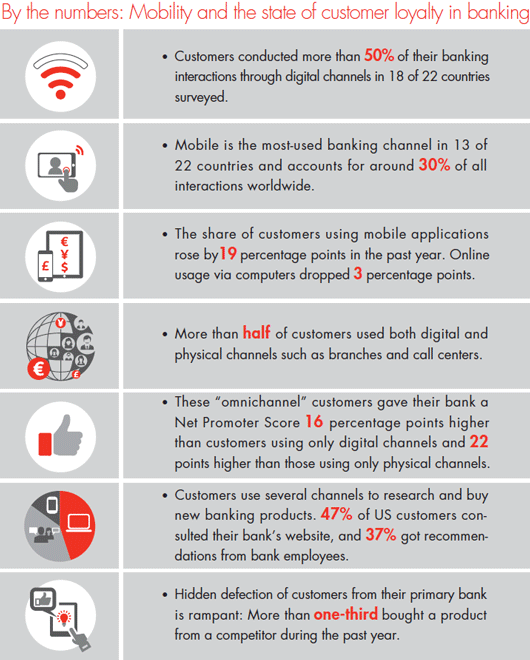
The meteoric rise of mobile
Mobile has become the dominant means for consumers to interact with their banks. Customers completed more interactions with their banks via smartphones or tablets than through any other channel in 13 of 22 countries we surveyed. And the share of customers using a bank’s mobile app rose a striking 19 percentage points during 2014, with strong increases across all age groups in most markets.
Until recently, consumers layered digital onto other ways of interacting with their bank—for instance, using mobile devices to check their balance more often while keeping their use of other channels the same. This year, the data shows a meaningful decline in usage of not only branches and ATMs but even online via computers; the latter dropped an average of 3 percentage points. (It’s possible that our survey slightly overstates growth in mobile usage, because the survey is conducted online and survey companies have been making questionnaires easier to answer via mobile devices. But we’re confident the trends are valid.)
Mobile does not replace other channels but fundamentally changes how consumers use them. Most customers in most markets (60% of respondents overall) used a combination of digital and physical channels to do their banking—what we call “omnichannel” behavior. This is critical for effective service, marketing and selling, because customers expect to be able to hop from one channel to another.
A virtuous circle: More channels, greater loyalty, more money
Omnichannel customers gave their bank an NPS that is 16 percentage points higher, on average, than the score customers who rely only on digital channels gave and 22 percentage points higher than the score given by those who use only physical channels. And NPS was even higher for omnichannel customers who had more interactions.
The payoff is higher product ownership: Omnichannel customers held an average of 1.0 more product with their primary bank than digital-only customers and 1.3 more than branch-only customers. While the data doesn’t prove a linear cause-and-effect relationship, it shows a virtuous circle of greater engagement across channels, greater loyalty and increased product holdings.
For many years, interactions in person or via phone were critical for delighting or angering customers during moments of truth, such as seeking advice. Now, leading banks are investing heavily in digital innovations designed to become powerful “wow” factors in their own right. In Spain, NPS leader Bankinter has an early lead in infusing its branches with useful digital technologies, such as biometric signatures for contracts, which save time, and tablets that enable self-service.
Likewise, Citibank in the US has steadily improved its NPS over the past four years, in part by deploying practical digital innovations. Examples include sending fraud alert texts to customers at the point of sale and deploying smart ATMs that allow customers to open accounts or hold videoconferences with experts. Several Asian banks, meanwhile, have pioneered personalization features. Shinhan in South Korea maintains a human touch through its use of “smart letters,” delivered through a mobile app. These letters range from simple birthday greetings to coupons providing higher interest rates.
Banks that pull ahead in loyalty by investing heavily in mobile to deliver a better experience will reap financial benefits. Those banks that lag in effectively investing in the mobile advantage will miss reaping the financial benefits and also fall further behind in their ability to invest.
One-third of banking customers have recently purchased a new product from a company that's not their primary bank. Gerard du Toit, a partner in Bain's Financial Services practice, explains how this "hidden defection" problem is making customer loyalty more important than ever.
The hidden defection problem—and opportunity
Accelerating the development of mobile sales capabilities will help banks address a significant but little-noticed problem: the hidden defection of customers who go to another provider for additional products such as mortgages and credit cards. Globally, more than one-third of customers bought a new banking product at a bank other than their primary bank this year.
Imagine the uproar that would ensue if one-third of a bank’s customers were completely defecting each year. Yet the defection highlighted here passes unnoticed because banks usually don’t know their customers were shopping in the first place and seldom know that they lost the sale. Mobile banking has the potential to either exacerbate or mitigate this problem.
Hidden defection could worsen as digital start-ups and specialist firms that are less encumbered by legacy systems and regulations offer better, simpler solutions and make it easy for people to find them. Banks that fail to respond risk getting saddled with the bulk of low-margin accounts, while other firms siphon off high-margin products like credit cards and mortgages. Young firms such as Betterment, which simplifies the process of investing, or Kabbage, which has developed an underwriting process to instantly lend up to $100,000, stand to capture a greater share of banks’ more profitable lines of business.
Some banks, such as JPMorgan Chase and USAA in the US, Nationwide in the UK and Hang Seng in Hong Kong, have begun to address defection through different combinations of earning strong loyalty, fielding strong products and improving sales capabilities. But for all banks, digital technology increasingly is critical for effective selling. When US consumers researched or considered a new financial product like a mortgage, they typically used at least four or five sources of information, with the most frequently used source being their bank’s website and the least used being mobile apps. Deploying mobile apps to make it easy for customers to connect to the right bank resources and employees during their shopping process, and preapproving them for the best offer, could substantially raise the odds of winning the sale.
How is the hard part
Winning in a Digical world, by fusing the best of customer-friendly digital tools and processes with physical assets, presents a challenge for banks, especially with their current operating model. Most banks’ operating models are characterized by products and channels that operate in silos and by processes that require extensive signoff from compliance, legal, finance, operations, marketing and other functions to make any change—50 people who can say no against just one who can say yes.
Banks will need to redesign their operating model, and they can take a cue from leading retailers. Macy’s, for example, has integrated most of its online shopping with its physical facilities, turning virtually all of its stores into omnichannel fulfillment centers. Its iconic Herald Square store in New York is undergoing a $400 million remodeling that features innovations such as interactive directories, digital signage, widespread use of radio-frequency identification (RFID) tagging and a new mobile app to guide customers as they shop. Macy’s has evolved its operating model in order to pursue this integration. The company now has a chief omnichannel officer, who reports directly to the CEO and manages the development of strategies to closely integrate stores and online and mobile activities. He also has responsibility for systems and technology, logistics and related operating functions.
Apple likewise recognized a need to change how it manages its online and physical stores. When Apple hired Angela Ahrendts, the former Burberry chief executive, it gave her responsibility for both online and retail stores, with a mission to make the customer experience seamless across channels.
Some leading banks are overcoming their organizational obstacles by taking a fresh “design, build, use” approach to developing exceptional customer experiences. Notably, the approach enlists customers to create the experience (see Figure 1). Here’s how it works.
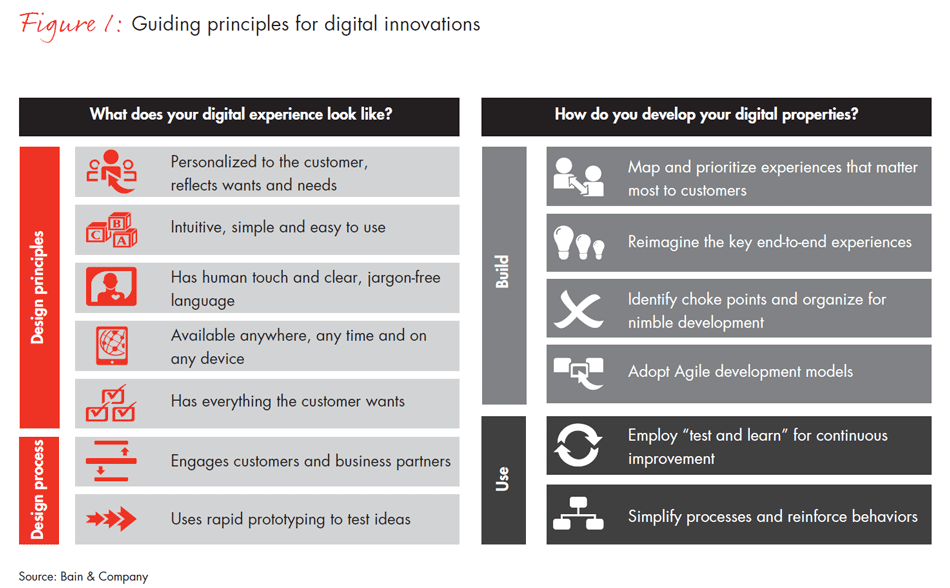
1. Design for the customer’s ideal experience.
Effective digital design focuses on the customers’ priorities—buy a home, provide for a daughter’s college education, manage cash and so on. Leading banks have found it useful to select the critical customer journeys by ranking them according to frequency of use and emotional importance (see Figure 2).
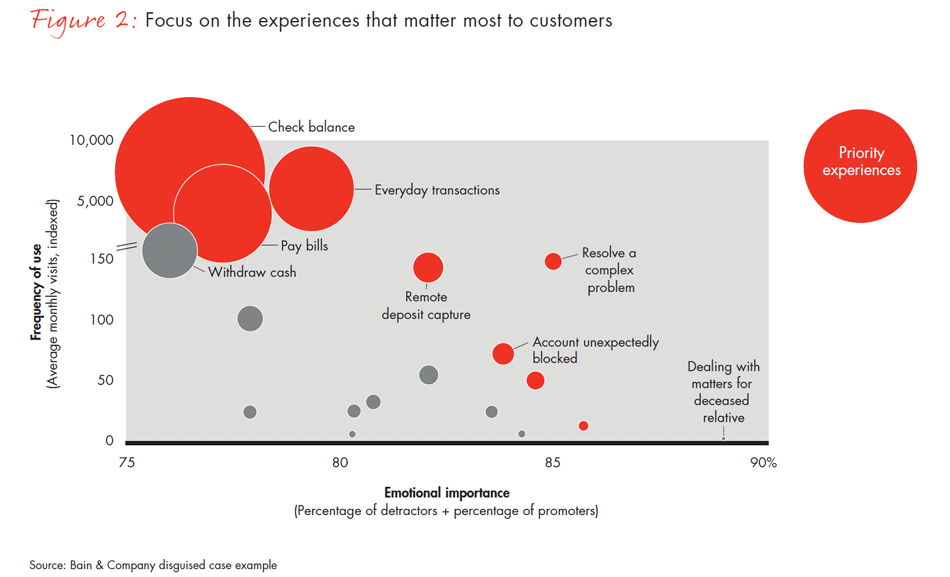
The next step is to reimagine each journey from the customer’s perspective. Buying a home, for instance, should start at the moment the customer considers house hunting and extend all the way through moving in. Journey mapping and benchmarking against banking competitors and best-in-class firms in other industries provide a data-driven audit to identify gaps in capabilities and appeal. It should be easy and intuitive for customers to navigate a website or a mobile app, and the presentation should feel empathetic and not clinical.
Benchmarking must be complemented by a design process that will allow a bank to stand out from the crowd. We have found that an effective mechanism to bring key customer moments to life is a storyboard created with the help of artists and writers. Storyboards, when combined with engaging real customers to cocreate digital tools through rapid prototyping and hands-on testing, lead to a clear view of the next horizon for each customer journey.
2. Build with a modern development model.
Given the speed of digital innovation these days, banks can’t afford to use the traditional waterfall IT development approach, which relies on remote release dates and thus struggles to catch up as the marketplace changes. The trend among leading organizations, such as Capital One Labs, is toward Agile delivery models. These deliver functionality in many bite-sized pieces.
Just installing Agile development teams is not enough. The entire ecosystem around the team needs to be redesigned and should include a process to ensure that the team building a particular journey has a pre-allocated budget, resources and approvals. The Agile model should also involve relevant compliance and legal staff on the team from the start. It should maintain regular communications with a senior executive leading the relevant line of business. And it can employ cloud-based development environments in order to reduce cycle times.
3. Use what really works with customers and employees.
In most bank trials, new approaches tend to succeed initially through small pilots in highly managed, carefully selected situations. But they fail to deliver the expected results in a mass rollout with all its complexity and variation. The more effective approach, which complements Agile development, is to test and learn more broadly, based on fast loops of customer feedback.
The test-and-learn approach relies on behavioral psychology, in which slight nuances can spell the difference between success and failure. Insights about what works often come from frontline employees and analysis of real customer behavior. At one Australian bank, for instance, a branch greeter charged with convincing customers to use self-service solutions realized that asking “Do you know how to do that yourself?” made customers defensive and thus fell flat. The more positive tone in “May I show you how to skip the line?” was much more effective. These sorts of insights happen regularly in every bank’s branch, but this bank had a process to quickly identify and spread the insight throughout the bank, so the entire system could benefit.
The chapters that follow explore the 2014 survey data on customer loyalty, how the right omnichannel approach in a mobile world earns loyalty and what the untapped opportunity is in capturing new purchases of banking products. These insights can inform the migration of transactional activities to digital channels, in order to reduce costly and avoidable volumes entering the branch. That will allow the branch network to become leaner and more oriented toward higher-value sales and service activities. Done right, the Digical journey can combine higher productivity with the ultimate touchstone: strong customer advocacy.
1. Global loyalty trends
- Customer loyalty as measured by NPS improved in 2014 from the previous year, as leading banks intensified their efforts to earn loyalty and many banks continued their recovery after the financial crisis.
- What matters most to an individual bank is how it performs relative to its peer group. Within national markets, NPS varied widely from bank to bank. In Germany, for instance, top-performer DKB had an NPS that was 74 percentage points higher than the worst performer and 55 percentage points above the country average. Sparda-Banken, a credit union, had a score 12 percentage points lower than DKB.
- Large traditional banks made meaningful improvements in NPS relative to their direct or smaller competitors in 2014. Several big banks, such as Santander and Barclays in the UK and JPMorgan Chase in the US, have shown sustained progress over the past few years.
- Several factors account for the progress of these banks, with digital innovation being one factor. Previous surveys have shown that using mobile banking contributed to higher loyalty scores. This year, we found that promoters of a bank, who score a 9 or 10 on a zero-to-10 NPS scale, were more likely to use mobile apps than were detractors, who score 6 or less on the same scale.
- Digital usage now accounts for the majority of banking interactions in virtually every country, with Australia, France, the US, Canada and Germany leading the digital share of all interactions. The sharpest growth came in mobile usage, which for the first time reached about 30% of all interactions in most countries. Mobile remains a relatively small share of digital interactions only in Germany, Portugal, Mexico and Japan.
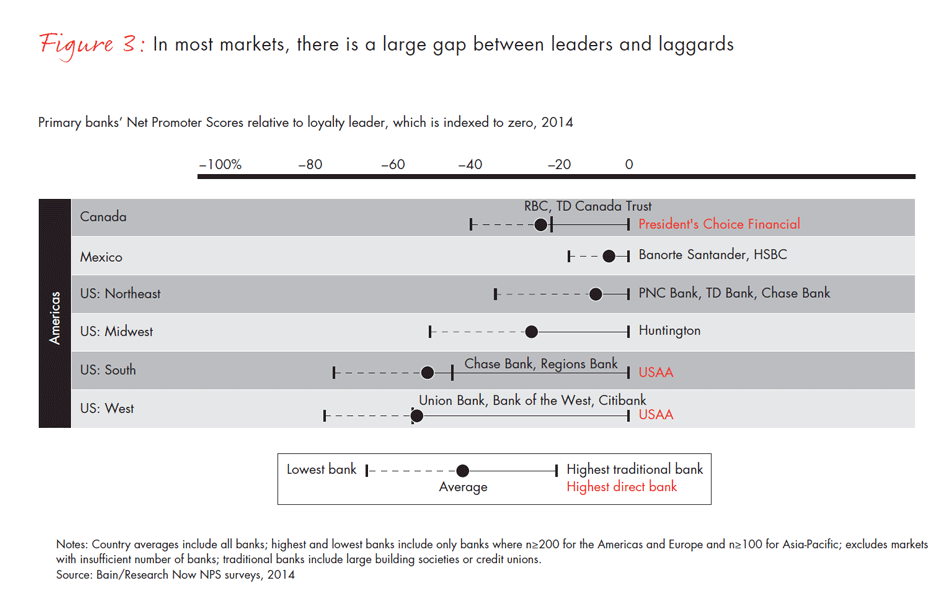
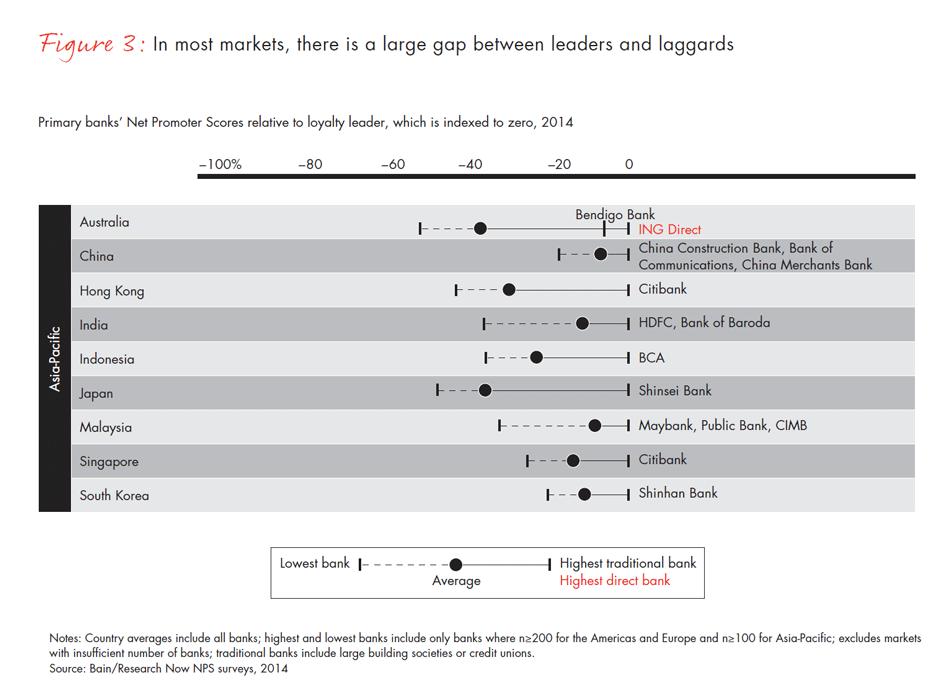
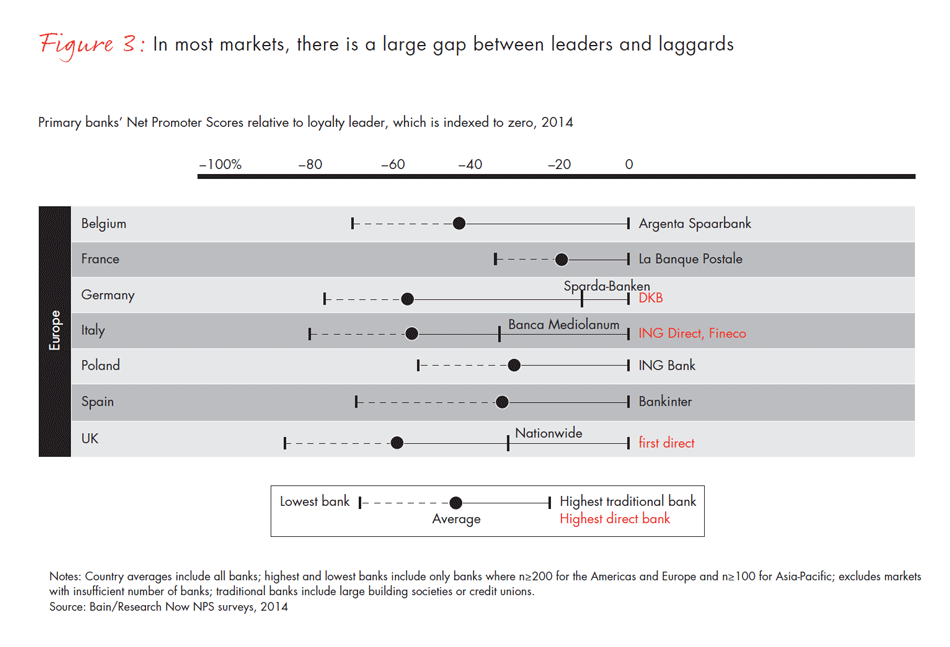
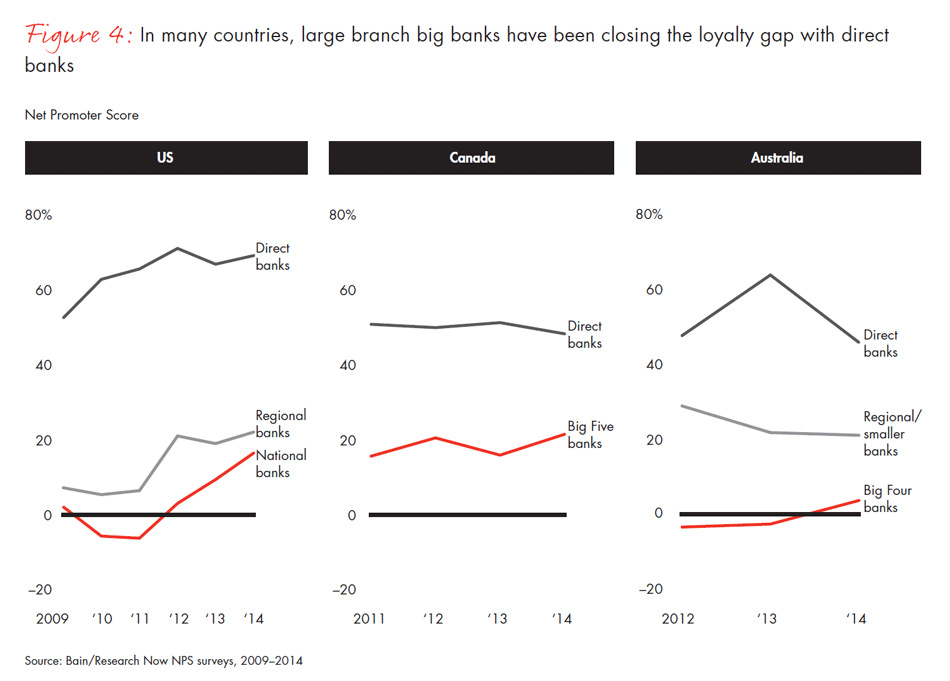
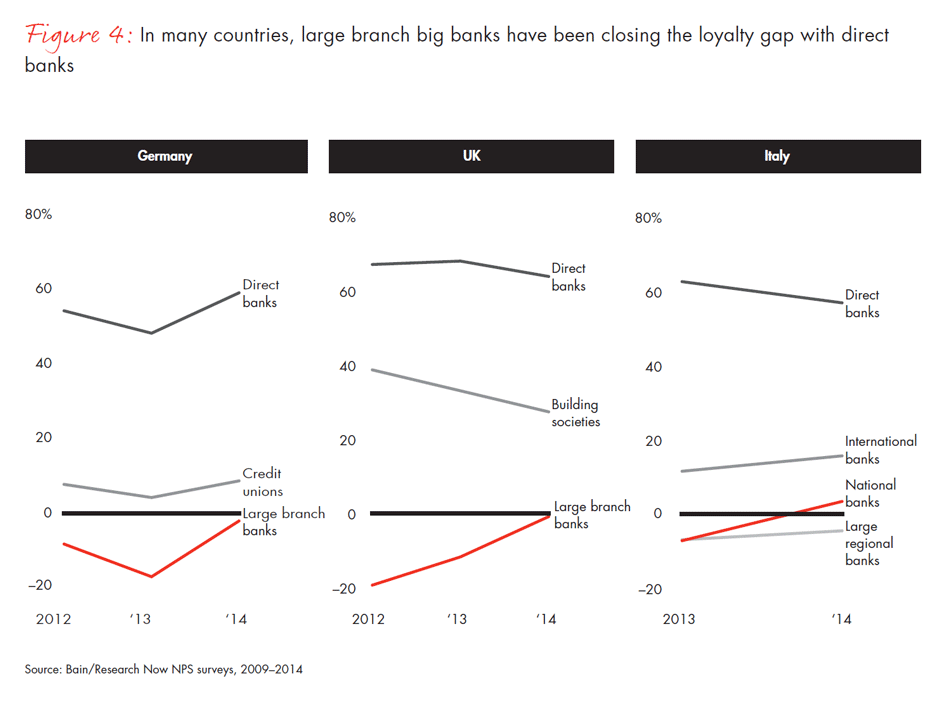
2. Channel behavior and its influence on loyalty
- Mobile applications have arrived at the stage of mass appeal. Almost every country showed a huge increase in the share of respondents using mobile apps, with an average 19 percentage point rise globally. Indonesia and China led in usage.
- Online usage showed declines or was flat everywhere except in Indonesia, Mexico and Japan— an average 3 percentage point decline worldwide.
- Growth in mobile has not just cut into online usage; it also coincided with declines in branch, ATM and phone usage. In the US the share of respondents using these channels dropped by 5, 3 and 5 percentage points, respectively, since 2012.
- Respondents under age 35 were more likely than older customers to bank via mobile devices. But the share of customers age 65 and older who use mobile is a substantial 30%—and mobile usage rose sharply among all age groups.
- Roughly 60% of customers used a combination of digital and physical channels. These omnichannel customers gave their primary bank an NPS that was 16 percentage points higher than the NPS of customers using only digital channels and 22 points higher than the NPS of those using only physical channels. They also own more products through their primary bank than those who use only digital or only physical channels: 1.0 and 1.3 products, respectively.
- For product research and consideration, US respondents most frequently turned to their bank’s website, highlighting the importance of a well-designed, intuitive site. Next, respondents turned to bank employees. Other sources—such as direct mail or, for credit cards, another website—had a prominent influence for individual products. Mobile has yet to be effectively tapped for selling.
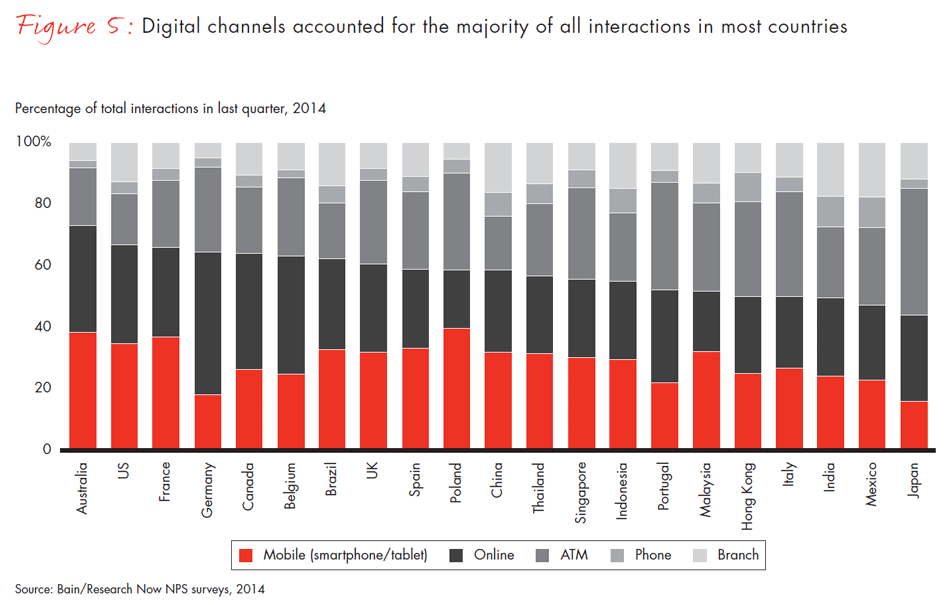
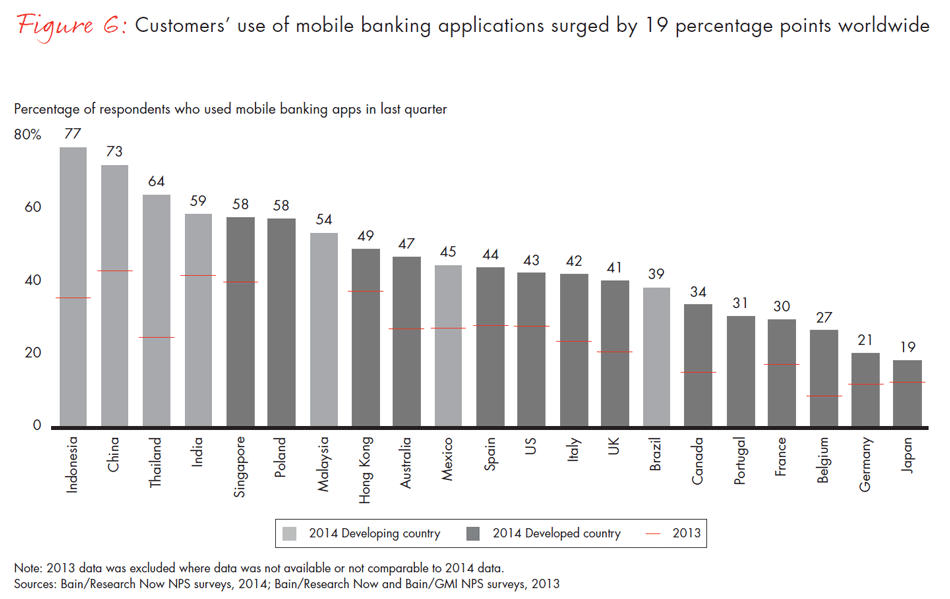
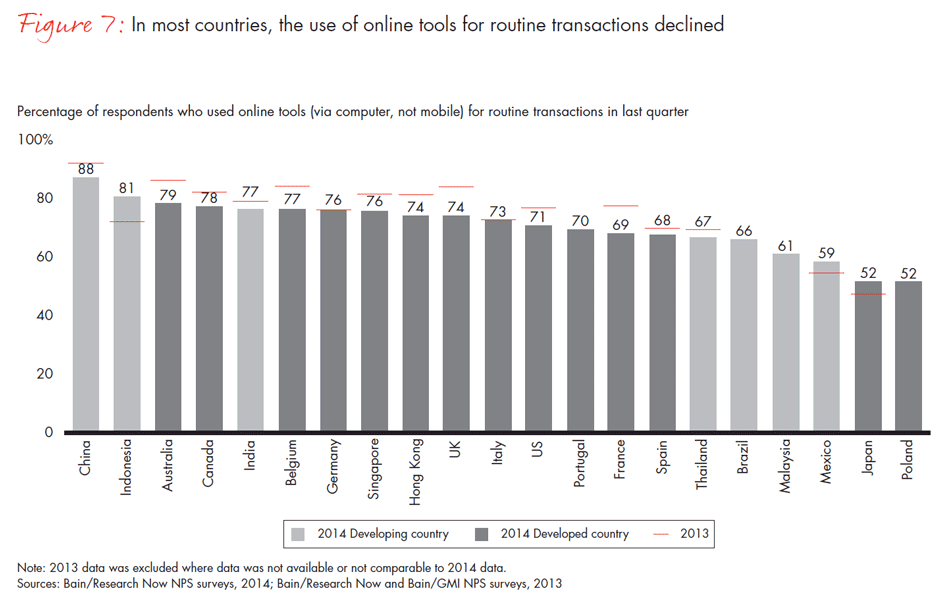
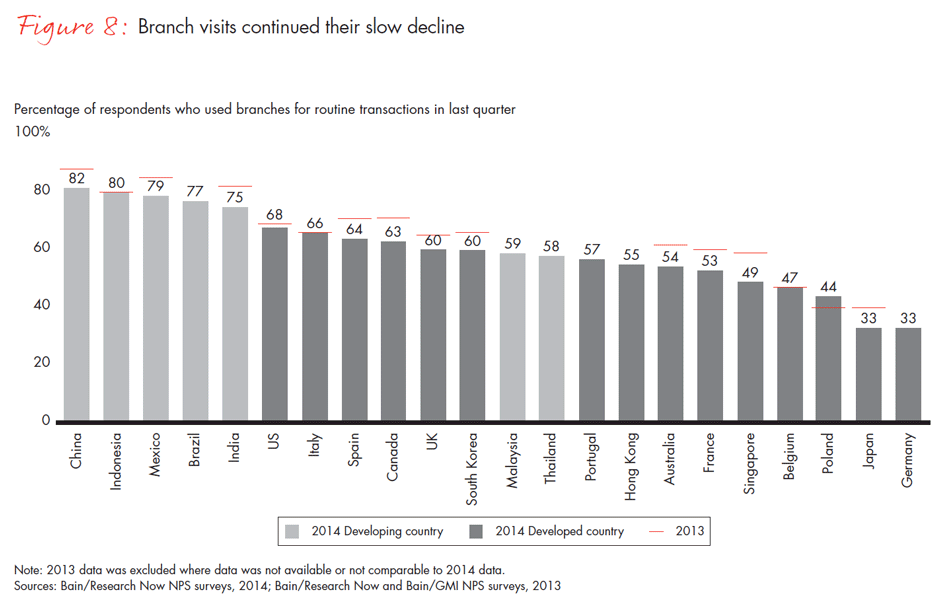
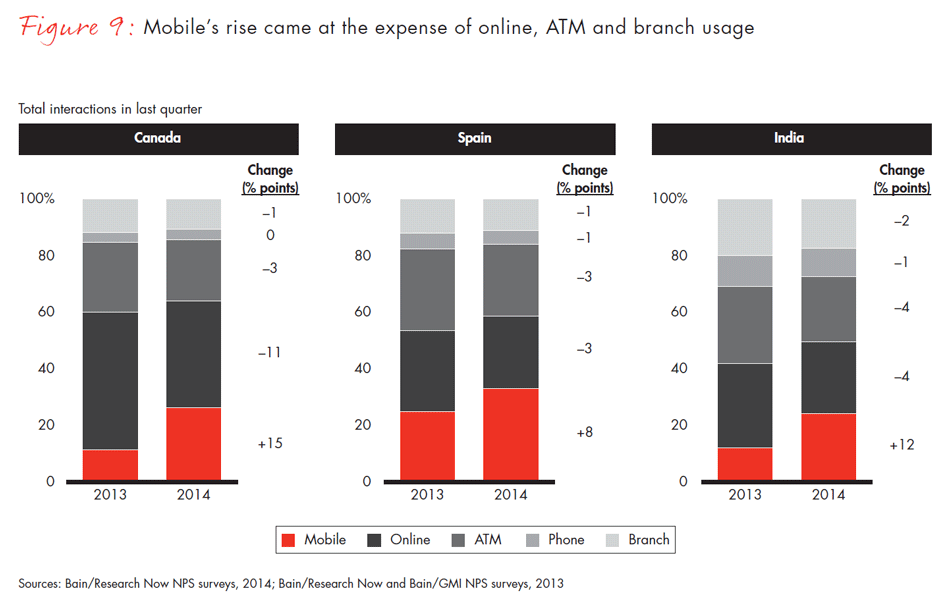
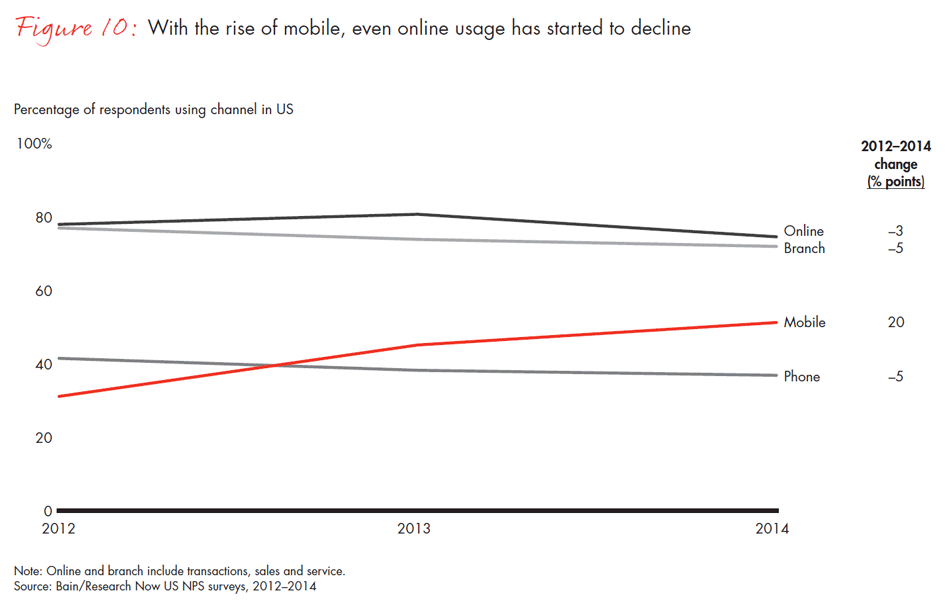
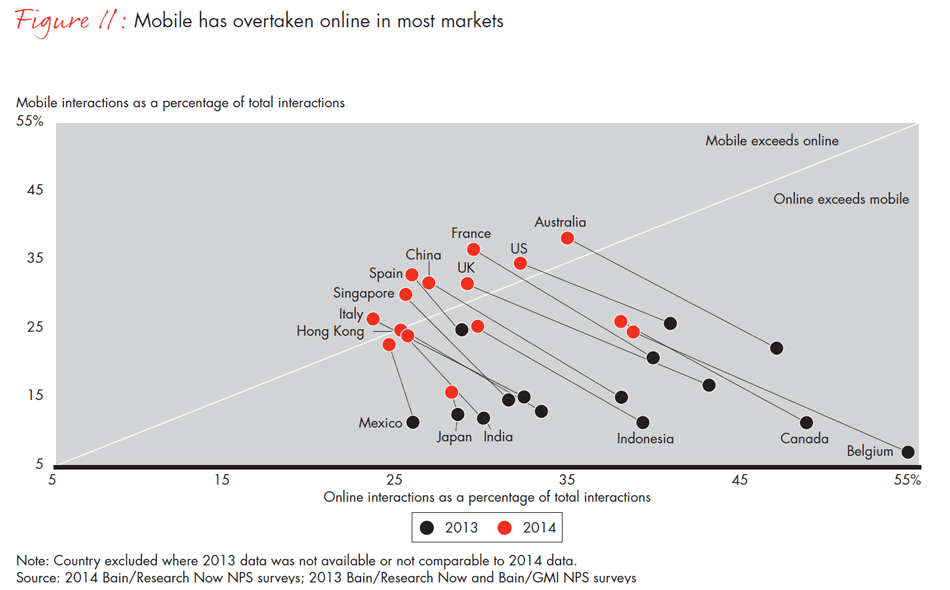
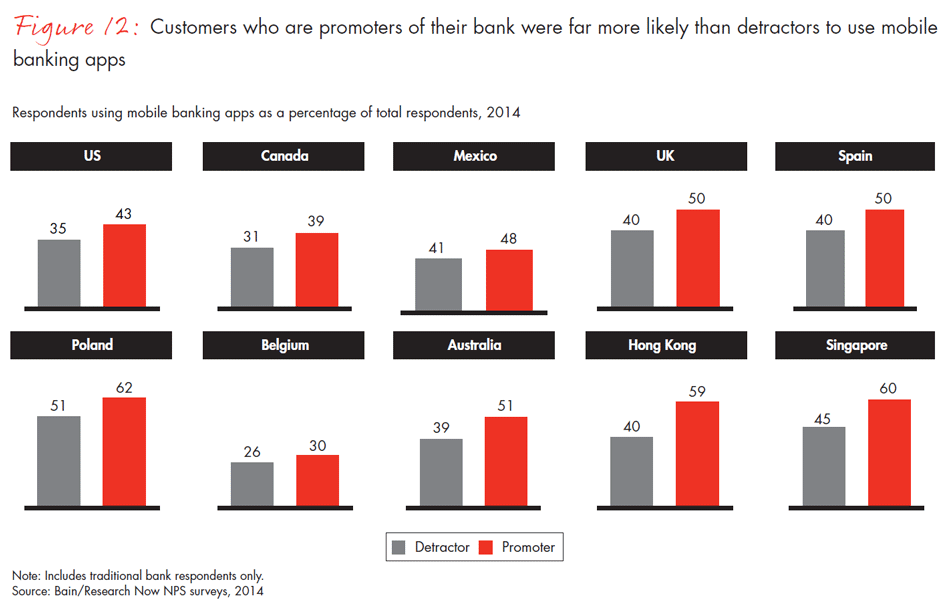
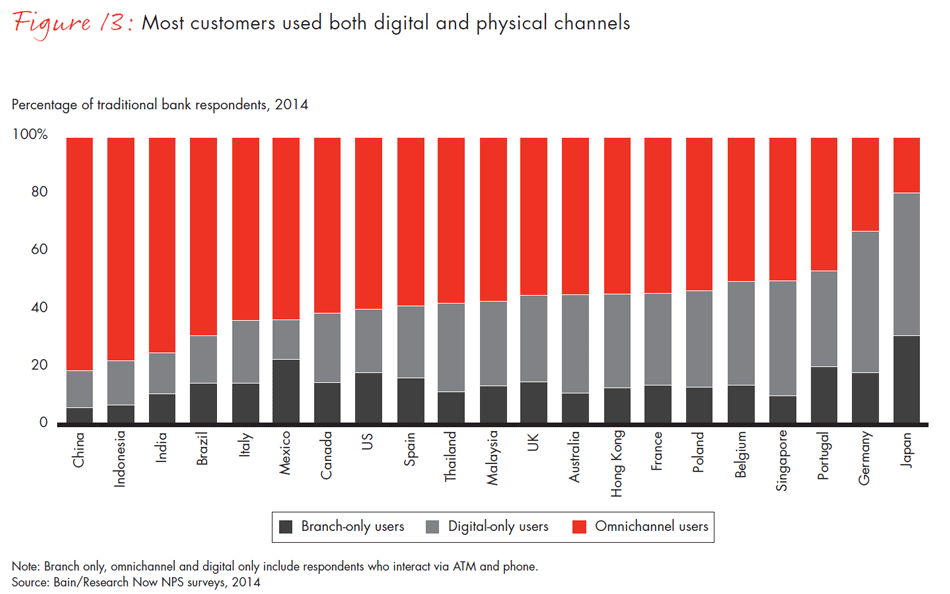
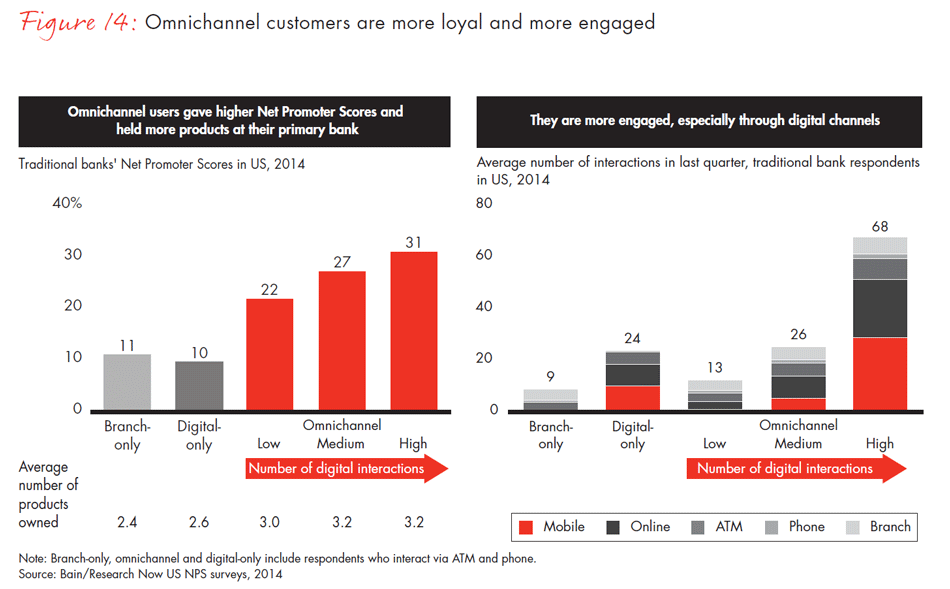
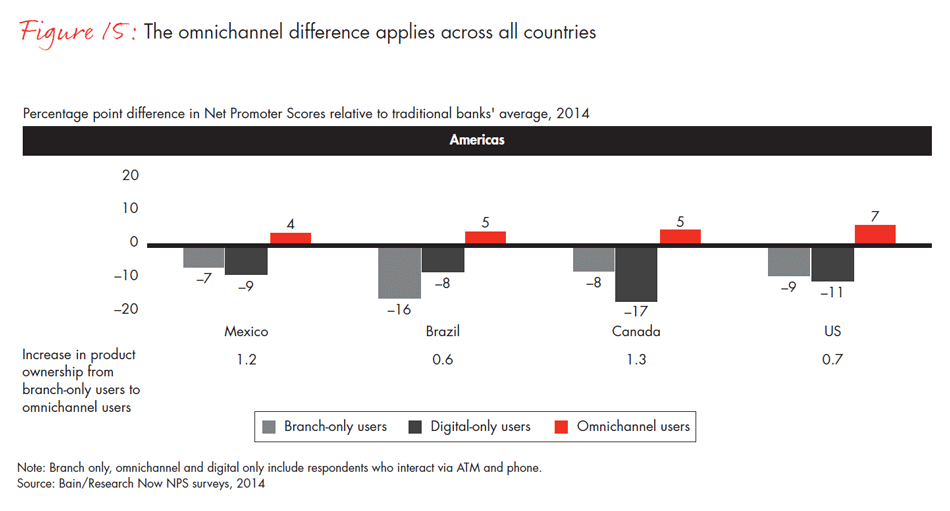
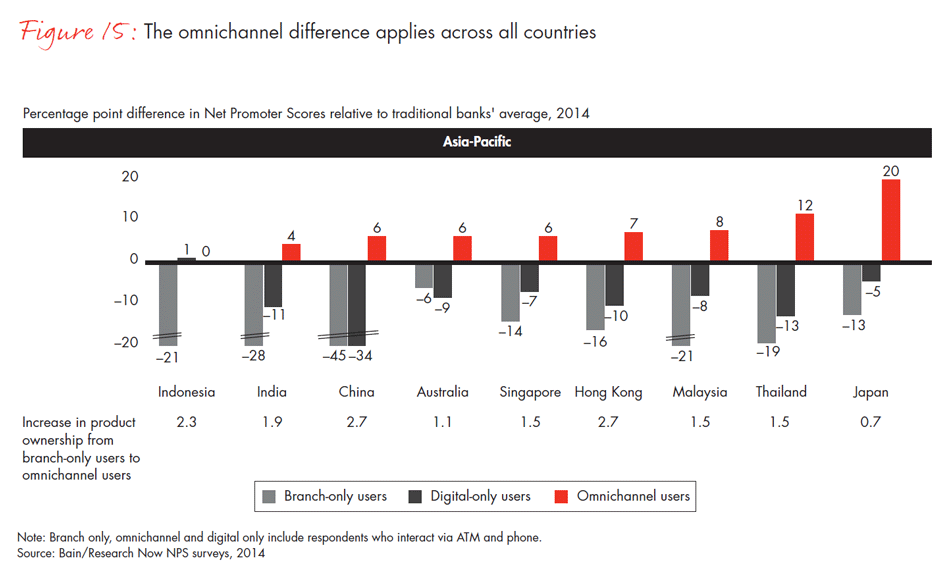
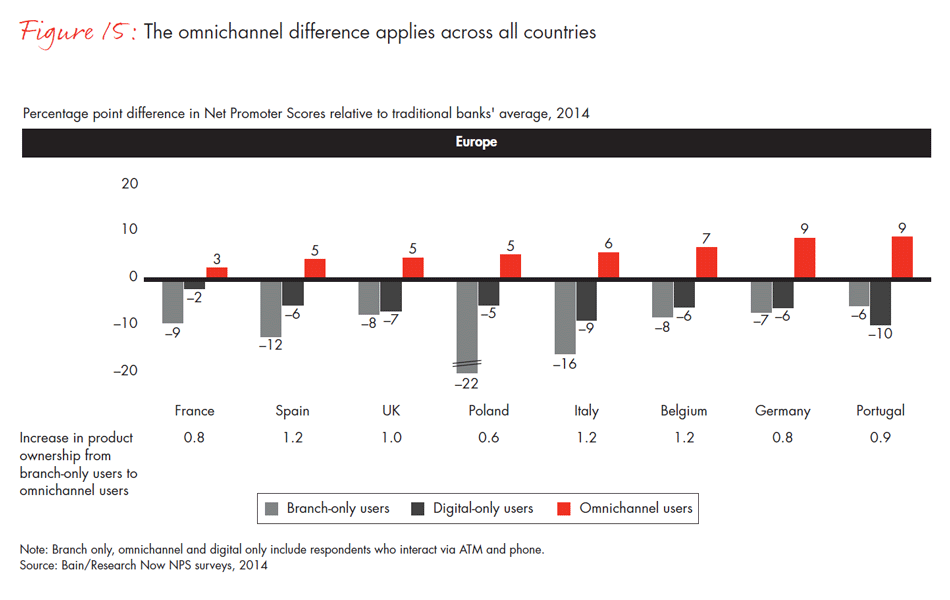
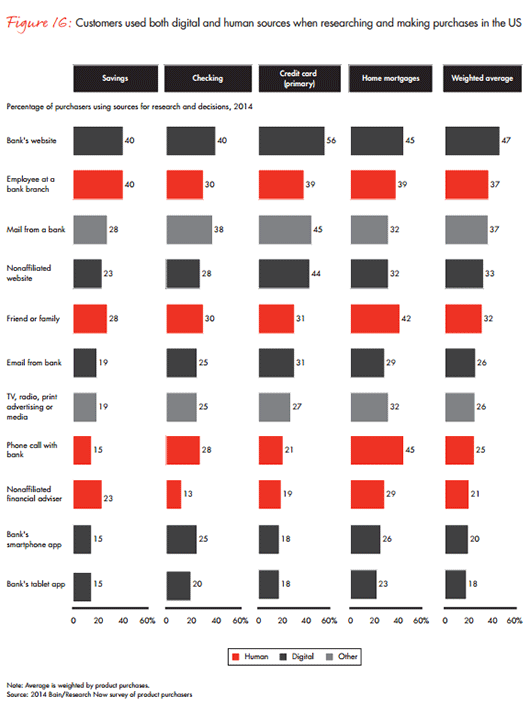
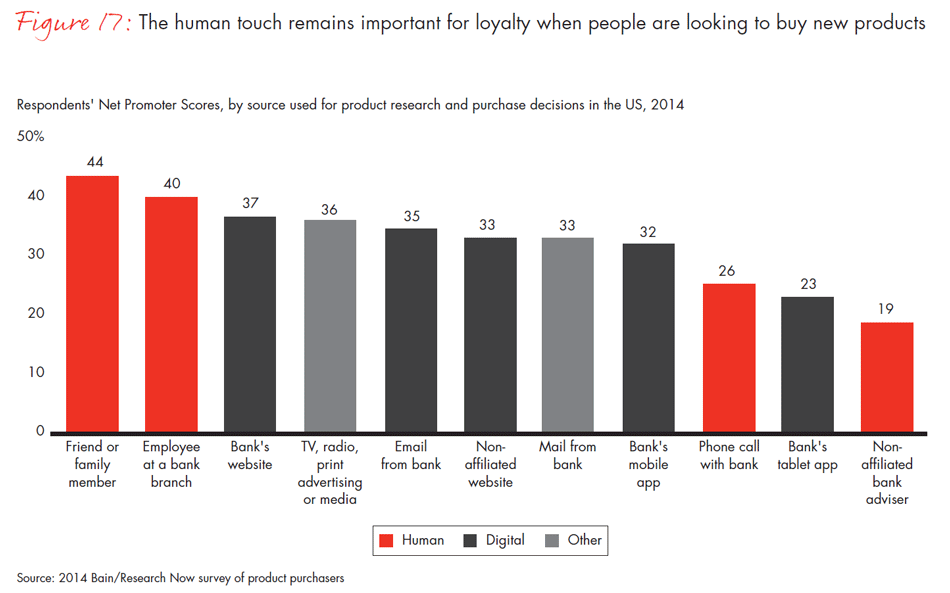
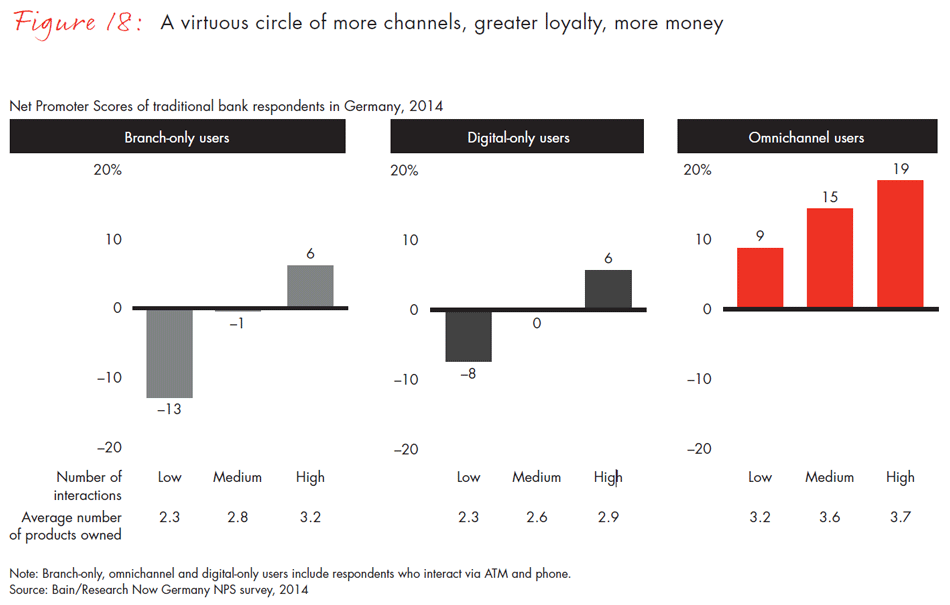
3. Product purchasing and ownership trends
- Globally, more than one-third of respondents bought financial products from a provider that was not their primary bank. That behavior was most pervasive in Asia, where a growing share of consumers are buying financial products for the first time, and least common in Western Europe. These hidden defectors bought high-value products in many cases, especially credit cards, loans, investments and insurance.
- Loyalty has a strong effect on additional product purchases at the primary bank. Promoters were more likely to buy from their bank than were detractors. This held true across almost every product in every country.
- The specific product effect varies by country because of regulatory and market structure differences. In the UK, the promoter uplift was strongest for pension products and weakest for checking accounts. In Germany, the greatest uplift came in instant-access accounts and life insurance. In the US and Japan, by contrast, auto loans had the greatest uplift.
- In retail banking, Bain estimates the lifetime value of a promoter is worth 2 to 2.5 times that of a detractor, depending on the national market, type of bank and wealth of the customer. That multiple stems largely from promoters’ tendency to buy more products from their bank, combined with their staying longer and recommending the bank to others.
- Banks have more latitude to influence customers’ purchases than they might realize. About one-third of respondents said that they were not planning to apply for a credit card but, upon receiving an offer, decided to accept the card. Product offers had a lower but still significant role in checking and mortgage products.
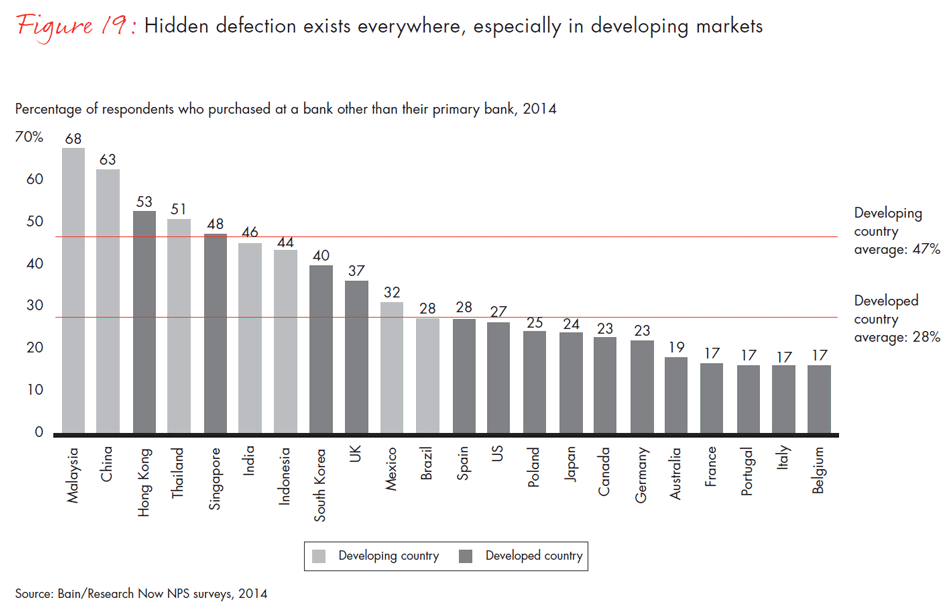
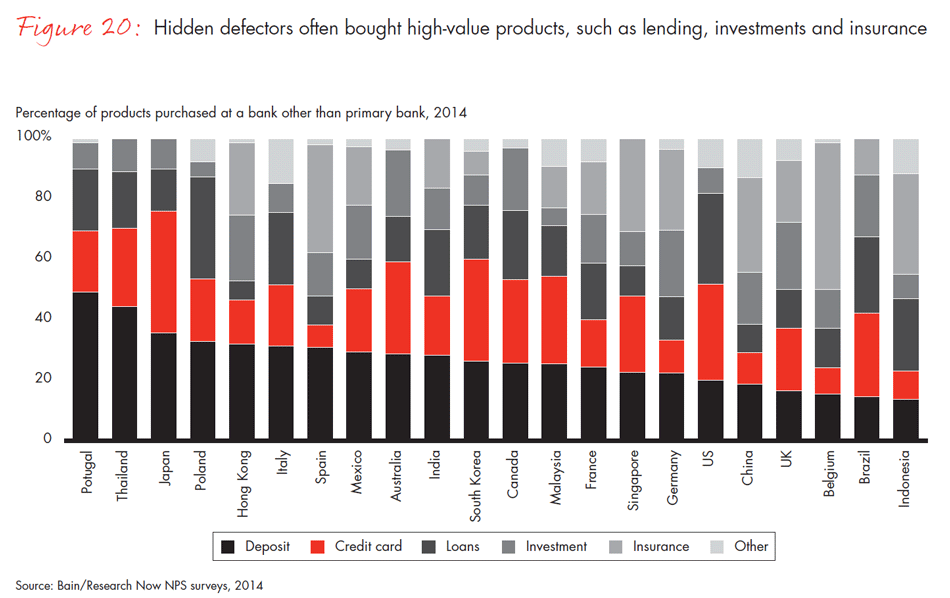
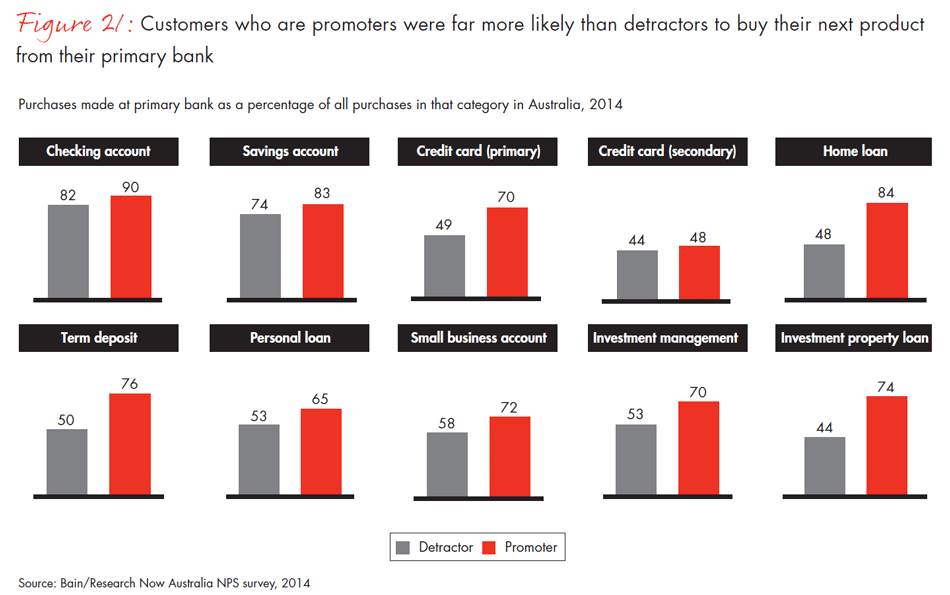
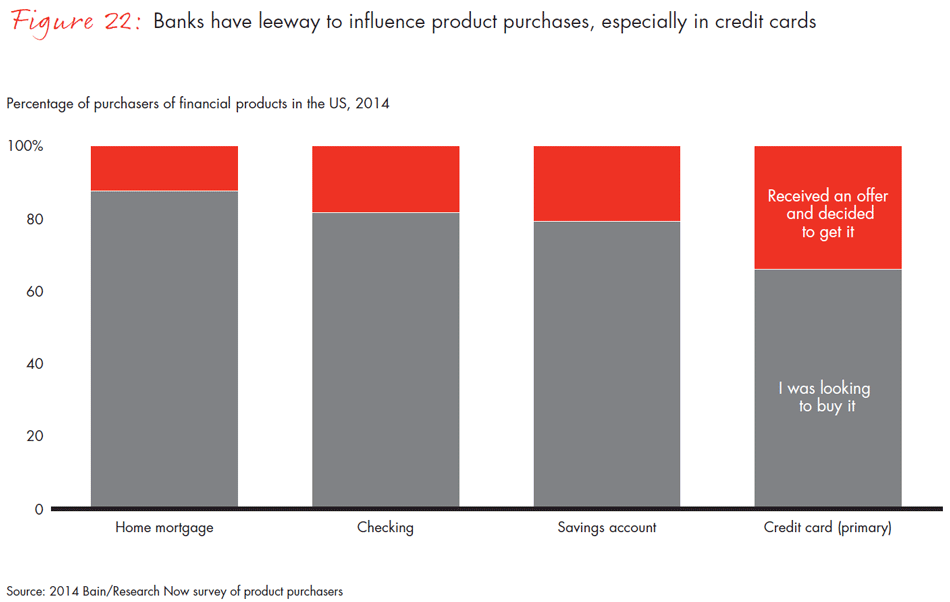
Further reading
- “Winning operating models that convert strategy to results,” Marcia Blenko, Eric Garton, Ludovica Mottura and Oliver Wright, Bain Brief, December 2014.
- “Rebooting IT: Why financial institutions need a new technology model,” Mike Baxter, Steve Berez and Vishy Padmanabhan, Bain Brief, September 2014.
- “Building the retail bank of the future,” Mike Baxter and Dirk Vater, Bain Brief, June 2014.
- “Digital-Physical mashups,” Darrell Rigby, Harvard Business Review, September 2014.
To see more information about methodology, please see the PDF.

























